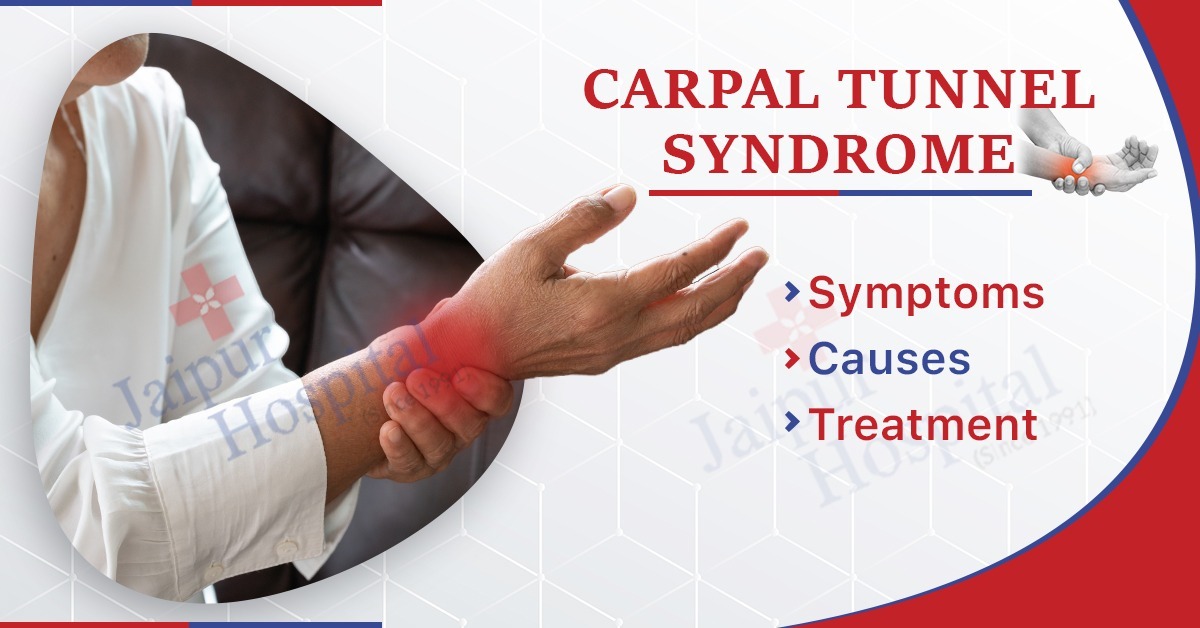Carpal Tunnel Syndrome (CTS) is a prevalent condition characterized by compression of the median nerve as it traverses through the carpal tunnel, a narrow passageway in the wrist. This condition often results in pain, numbness, and tingling in the hand and arm, potentially impacting daily activities and overall quality of life. In this discussion, we will explore the anatomy and physiology of the carpal tunnel, the etiology and risk factors contributing to CTS, the clinical presentation and diagnostic methods, and the various treatment options ranging from conservative management to surgical intervention. Understanding these facets is crucial for effectively diagnosing, managing, and preventing Carpal Tunnel Syndrome.
Symptoms of Carpal Tunnel Syndrome
Carpal Tunnel Syndrome (CTS) manifests through a variety of symptoms that can significantly impact daily activities and quality of life. The primary symptoms include:
- Numbness and Tingling: Patients often experience numbness and tingling in the thumb, index, middle, and part of the ring fingers. These sensations are usually most pronounced at night and can disrupt sleep.
- Pain: Pain in the wrist and hand, which can extend up the arm, is a common symptom. This pain may be exacerbated by activities involving repetitive hand and wrist motions.
- Weakness: Weakness in the hand and a tendency to drop objects are frequently reported by individuals with CTS. This is due to the impaired function of the median nerve.
- Burning Sensation: Some patients describe a burning sensation in the affected fingers, which can be particularly uncomfortable and persistent.
- Clumsiness: Difficulty with fine motor skills, such as buttoning clothes or typing, may occur due to decreased hand coordination and strength.
- Swelling Sensation: Although there is often no visible swelling, patients may feel as though their fingers are swollen.
Early recognition and treatment of these symptoms are crucial to prevent permanent nerve damage and maintain hand function.
Causes of Carpal Tunnel Syndrome
Carpal Tunnel Syndrome (CTS) arises from a variety of factors that contribute to the compression of the median nerve within the carpal tunnel. The primary causes and risk factors include:
- Repetitive Hand Movements: Activities that involve repetitive motions of the hand and wrist, such as typing, using a mouse, or assembly line work, can lead to inflammation and swelling in the carpal tunnel.
- Anatomical Factors: Some individuals may have a naturally smaller carpal tunnel, which predisposes them to nerve compression. Anatomical differences or deformities due to fractures or arthritis can also narrow the carpal tunnel.
- Medical Conditions: Certain health conditions increase the risk of developing CTS. These include diabetes, rheumatoid arthritis, thyroid dysfunction, and obesity. These conditions can cause swelling and inflammation in the carpal tunnel area.
- Pregnancy: Hormonal changes during pregnancy can lead to fluid retention and swelling, increasing the pressure within the carpal tunnel and compressing the median nerve. This condition often resolves after childbirth.
- Genetics: There may be a hereditary component, as CTS can run in families. Genetic predisposition can influence the carpal tunnel size and the body’s response to repetitive stress and inflammation.
- Workplace Factors: Jobs that involve prolonged use of vibrating tools or positions that require extreme flexion or extension of the wrist are associated with a higher incidence of CTS.
- Age and Gender: CTS is more common in older adults and women, possibly due to hormonal factors and differences in wrist anatomy.
Risk Factors of Carpal Tunnel Syndrome
Carpal Tunnel Syndrome (CTS) is influenced by a range of risk factors that increase the likelihood of developing the condition. These include:
- Repetitive Hand Use: Engaging in activities that require repetitive motions of the hand and wrist, such as typing, assembly line work, or using vibrating tools, can lead to inflammation and pressure on the median nerve.
- Workplace Factors: Jobs that involve forceful or prolonged hand and wrist movements, awkward wrist positions, or the use of vibrating equipment are associated with a higher risk of CTS.
- Medical Conditions: Certain health conditions predispose individuals to CTS. These include diabetes, rheumatoid arthritis, thyroid disorders, and gout, which can cause inflammation and swelling in the wrist.
- Pregnancy: Hormonal changes and fluid retention during pregnancy can increase pressure within the carpal tunnel, making pregnant women more susceptible to CTS. Symptoms often resolve postpartum.
- Obesity: Excess body weight can contribute to increased pressure on the median nerve, raising the risk of CTS.
- Age: The likelihood of developing CTS increases with age, with a higher prevalence observed in individuals over the age of 40.
- Gender: Women are more likely to develop CTS than men, possibly due to hormonal differences, smaller carpal tunnel anatomy, and higher incidence of conditions like arthritis.
- Genetics: A family history of CTS can indicate a genetic predisposition to developing the condition, as anatomical differences and susceptibility to inflammation can be inherited.
- Previous Injuries: Wrist injuries, fractures, or trauma can alter the structure of the carpal tunnel, increasing the risk of nerve compression.
- Lifestyle Factors: Smoking and a sedentary lifestyle may contribute to poor circulation and nerve health, indirectly increasing the risk of CTS.
Treatment for Carpal Tunnel Syndrome
Treatment for Carpal Tunnel Syndrome (CTS) aims to relieve symptoms and prevent further nerve damage. The approach can vary based on the severity of the condition and the patient’s overall health. Treatment options include:
Conservative Treatments:
- Activity Modification: Reducing or modifying activities that exacerbate symptoms, such as taking frequent breaks from repetitive tasks, can help alleviate pressure on the median nerve.
- Wrist Splinting: Wearing a wrist splint, especially at night, keeps the wrist in a neutral position, reducing pressure on the median nerve and relieving symptoms.
- Ergonomic Adjustments: Improving workplace ergonomics, such as adjusting the height of a desk or chair and using ergonomic keyboards and mice, can reduce strain on the wrist.
- Non-Steroidal Anti-Inflammatory Drugs (NSAIDs): Over-the-counter NSAIDs, like ibuprofen, can help reduce pain and inflammation.
- Corticosteroid Injections: Injecting corticosteroids into the carpal tunnel can provide temporary relief from symptoms by reducing inflammation and swelling.
- Physical Therapy: Specific exercises and stretches can improve wrist strength and flexibility, helping to alleviate symptoms.
Medical and Surgical Treatments:
- Oral Medications: In some cases, doctors may prescribe oral corticosteroids or other medications to reduce inflammation and pain.
- Ultrasound Therapy: High-frequency sound waves can be used to reduce inflammation and pain in the carpal tunnel area.
- Surgical Intervention: If conservative treatments are ineffective and symptoms persist or worsen, surgery may be recommended. The most common procedure is carpal tunnel release surgery, which involves cutting the transverse carpal ligament to reduce pressure on the median nerve. This can be performed through an open or endoscopic technique.
Alternative Treatments
- Acupuncture: Some patients find relief from symptoms with acupuncture, although scientific evidence on its effectiveness is limited.
- Chiropractic Care: Chiropractic adjustments and manipulations may help reduce symptoms for some individuals.
- Yoga: Specific yoga postures designed to strengthen and stretch the wrists, hands, and arms can help alleviate CTS symptoms.
Also Read:-Thyroiditis: Types, Causes, Symptoms, Diagnosis & Treatment
Prevention Tips for Carpal Tunnel Syndrome:
Preventing Carpal Tunnel Syndrome (CTS) involves strategies to minimize wrists and hands’ stress and strain. Here are several effective prevention tips:
- Ergonomic Workstation: Ensure your workspace is ergonomically designed to reduce strain on your wrists. Position your keyboard so that your wrists remain in a neutral position, and use a mouse that is comfortable and minimizes wrist movement.
- Proper Posture: Maintain good posture while sitting, keeping your wrists straight and your hands slightly below or level with your elbows. This helps reduce unnecessary stress on your wrists.
- Frequent Breaks: Take regular breaks from repetitive tasks to give your hands and wrists a rest. Stretch and shake out your hands periodically to improve circulation.
- Wrist Position: Avoid bending your wrists excessively up or down. Keep them in a neutral, straight position as much as possible, especially during tasks that require repetitive motions.
- Hand and Wrist Exercises: Perform stretching and strengthening exercises for your hands and wrists. Gentle stretches can improve flexibility and reduce tension in the muscles and tendons.
- Proper Technique: Use proper techniques when performing repetitive tasks. For example, when typing, use a light touch and avoid pressing the keys too hard. Adjust your grip on tools to be as relaxed as possible.
- Ergonomic Tools: Use ergonomic tools and equipment designed to reduce strain on your hands and wrists. Ergonomic keyboards, mice, and wrist rests can help maintain proper wrist alignment.
- Temperature Control: Keep your hands warm. Cold environments can contribute to stiffness and pain, increasing the risk of CTS. Wear gloves if necessary to maintain warmth.
- Healthy Lifestyle: Maintain a healthy weight, exercise regularly, and avoid smoking. Good overall health can reduce the risk of conditions that contribute to CTS, such as obesity and poor circulation.
- Early Intervention: Pay attention to early signs of discomfort or tingling in your hands and wrists. Addressing symptoms early can prevent the progression of CTS. Seek medical advice if symptoms persist.
Conclusion:
Carpal Tunnel Syndrome (CTS) is a common yet debilitating condition characterized by pain, numbness, and weakness in the hand and wrist due to median nerve compression. Understanding the symptoms, causes, risk factors, and treatment options is crucial for effective management and prevention. Preventive measures such as ergonomic adjustments, proper posture, and regular exercise can significantly reduce the risk of developing CTS. For those experiencing persistent symptoms, seeking medical intervention is essential to prevent long-term damage. Jaipur Hospital, renowned for its exceptional neurological care, stands out as the best choice for comprehensive diagnosis, treatment, and management of Carpal Tunnel Syndrome. With its state-of-the-art facilities and expert medical team, Jaipur Hospital ensures that patients receive the highest standard of care to regain their quality of life.


